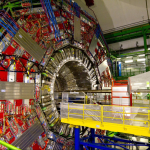Magnetic News: First U.S.- built Focusing Magnet for LHC Upgrade Arrives in Switzerland
Recently in Geneva, Switzerland, the renowned physics laboratory, CERN, welcomed a significant delivery all the way from the US. It contained a colossal 13-meter-long package housing two magnets, each equipped with 4.2-meter-long coils. These specialized magnets mark a groundbreaking milestone as the inaugural U.S.-crafted components for the high-luminosity upgrade of the Large Hadron Collider (LHC), which is the world’s largest and most powerful particle accelerator.
This achievement caps off years of meticulous design and construction efforts led by a consortium of U.S. Department of Energy national laboratories to create novel accelerator focusing magnets. These magnets, in conjunction with those from CERN, will be strategically installed around two collision points within the LHC in forthcoming years.
Mike Lamont, CERN’s director for accelerators and technology, emphasized, “In colossal scientific undertakings like the [high luminosity]-LHC, global collaboration and expertise are vital. The delivery of the first cryo-assembly housing validated niobium-tin series magnets stands as a tangible testament to the triumph of the U.S. Accelerator Upgrade Project.”
The LHC: Unraveling the Mysteries of the Universe
The Large Hadron Collider operates by colliding protons and other atomic nuclei at velocities nearing light speed, recreating conditions reminiscent of the moments post-Big Bang. Scientists scrutinize these collisions to unravel the mysteries of subatomic particles and fundamental physical laws. Their pursuit of answers to life’s most profound questions — such as the nature of dark matter, the disappearance of antimatter, and the acquisition of particle mass during the universe's infancy — fuels their research.Accelerated Data Collection at an Unprecedented Pace
The U.S.-developed magnets from the HL-LHC Accelerator Upgrade Project play a crucial role in tightly confining the two opposing proton beams circulating around the LHC just before the collision. This enhanced confinement is poised to amplify the LHC’s collision rate by a factor of 5 from its original design value. Coupled with additional upgrades, this advancement promises accelerated data collection at an unprecedented pace. With these vast datasets at their disposal, scientists anticipate delivering into exceptionally rare subatomic events with remarkable precision, surpassing the limits of current LHC capabilities. That said, enhancing the collision rate posed some significant challenges. Scientists had to engineer magnets potent enough to focus and compress the LHC’s proton beams into considerably tighter bundles during head-on collisions. But how?Superconductor to Focus & Compress the LHC’s Proton Beams
The answer lies in an infrequently used yet finicky superconducting material—niobium-3-tin, or Nb3Sn. When chilled with liquid helium to a frigid -271.25 degrees Celsius, Nb3Sn exhibits outstanding superconductivity, conducting electricity without resistance. This specific type of superconductor boasts the capacity to attain higher magnetic fields compared to the standard niobium-titanium utilized in current LHC superconducting magnets. The newly developed magnets generate a maximum magnetic field of 12 tesla, approximately 50% more powerful than the strength of the niobium-titanium focusing magnets currently operational within the Large Hadron Collider. However, employing Nb3Sn in a large-scale accelerator project posed formidable challenges due to its extreme difficulty in handling. Giorgio Apollinari, the head of the HL-LHC accelerator upgrade project at the U.S. Department of Energy’s Fermi National Accelerator Laboratory, likened its fragility to glass, remarking, “It’s as brittle as glass. Just like how glass can endure for centuries in a cathedral window but shatter upon impact, handling this material required extensive study and addressing its inherent brittleness.” In 2003, the U.S. Department of Energy initiated the LHC Accelerator Research Program, aiming to explore Nb3Sn's properties and integrate it into accelerator magnets. By 2015, laboratories involved in the program were prepared for production. The first HL-LHC cryo-assembly was finalized in 2022 and successfully cleared testing at Fermilab in 2023.A New Version of Bubble Wrap
The logistics of shipping magnets and their components among various U.S. laboratories constituted the backbone of the upgrade project. Apollinari highlighted the challenge of safely transporting a 25-ton cryo-assembly across the globe, noting, “You can't simply buy Styrofoam or bubble wrap off the shelf to package it for shipment.” Ensuring the magnet's pristine condition and preventing damage during transit was paramount. Consequently, the magnet team adopted an approach akin to a scientific experiment, constructing a dummy magnet from 25 tons of concrete and iron embedded with sensors, driving it cross country and shipping it to CERN by sea. Leveraging this data, they designed specialized shipping equipment and a meticulous shipment plan accounting for the forces and accelerations tolerable by the magnet. After enduring a month-long journey by land and sea, the actual magnet arrived at CERN in November 2023. Subsequently, CERN personnel will install it—alongside seven more from the United States and eight from CERN—100 meters underground in the LHC tunnel to focus the particle beams converging at the collision points of two of the largest LHC experiments. The HL-LHC installation is slated to commence in 2025, with the goal of initiating proton collisions using the upgraded machine by 2029.Apex Magnets
Again and again, magnets are at the center of the search to uncover the mysteries of the universe. At Apex Magnets, we want our magnets to be at the center of your search for efficient business processes, cost savings, and more. If you want to shop our amazing magnets, start here!

